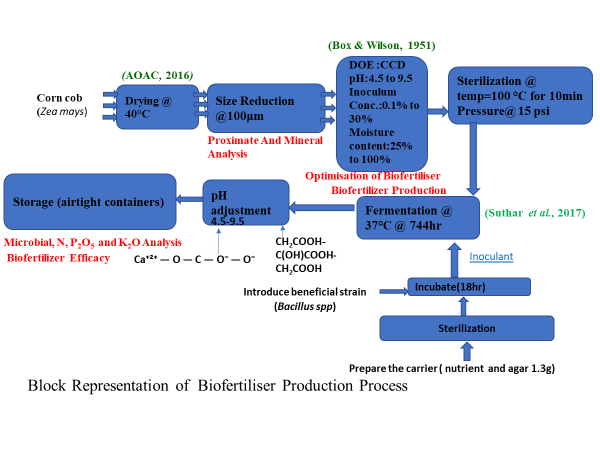DEVELOPMENT AND CHARACTERIZATION OF BIOFERTILIZER FROM CORN COB (Zea mays) WASTE: A SUSTAINABLE APPROACH FOR SOIL ENRICHMENT AND ENVIRONMENTAL MANAGEMENT
Keywords:
Biofertilizer, Corn Cob, Fermentation, Optimization, SoilAbstract
This study developed and characterized a corn cob based biofertilizer as a sustainable alternative to chemical fertilizers and a means of agricultural waste valorization. Corn cobs were dried at 40 °C, milled to 20 µm, sterilized at 100 °C for 10 min, and inoculated with Bacillus spp., followed by fermentation at 37 °C for 744 h under conditions optimized using Central Composite Design (CCD). The design variables included pH (4.5–9.5), inoculum concentration (0.1–30%) and moisture content (25–100%). Proximate and mineral analyses confirmed that corn cobs provided a nutrient-rich substrate containing 43.5% carbohydrates, 3.4% crude protein, 35.6% fibre, 0.55% nitrogen, 1.5% potassium and 0.65% phosphorus. Optimization produced a biofertilizer containing 1.55% nitrogen, 1.63% potassium and 1.78% phosphorus, with a high microbial load of Bacillus (2.1 × 10⁶ CFU ml⁻¹). Soil trials conducted across sandy, loamy, and clay soils revealed significant improvements in soil fertility indices: There was an observed increase in pH, nutrient levels (nitrogen, phosphorus and potassium), Organic carbon, cation exchange capacity and also Bacillus counts in all the soil types before and after treatment, indicating robust microbial proliferation. Overall, these findings establish corn cobs as a viable carrier matrix for biofertilizer production. The resulting formulation is nutrient-enriched, microbially active, cost-effective and environmentally friendly, demonstrating significant potential for improving soil fertility and promoting sustainable agricultural practices.

Published
How to Cite
Issue
Section
Copyright (c) 2025 SERGIUS T UGWUEKE, Daniel D Musa, Alexander A. Bem, Ehime Itama

This work is licensed under a Creative Commons Attribution 4.0 International License.




